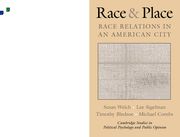Book contents
- Frontmatter
- Contents
- List of Figures
- List of Tables
- Preface
- 1 Introduction
- 2 Race Relations in Detroit, 1968–1992
- 3 Black–White Social Interaction
- 4 Perceptions of Racial Discrimination
- 5 Black Racial Solidarity
- 6 White Racial Prejudice
- 7 Opinions on Urban Issues: The Schools and the Police
- 8 Conclusions
- Appendix A The Detroit Surveys
- Appendix B Detroit Survey Items and Measures
- References
- Author Index
- Subject Index
- Miscellaneous Endmatter
5 - Black Racial Solidarity
Published online by Cambridge University Press: 05 June 2012
- Frontmatter
- Contents
- List of Figures
- List of Tables
- Preface
- 1 Introduction
- 2 Race Relations in Detroit, 1968–1992
- 3 Black–White Social Interaction
- 4 Perceptions of Racial Discrimination
- 5 Black Racial Solidarity
- 6 White Racial Prejudice
- 7 Opinions on Urban Issues: The Schools and the Police
- 8 Conclusions
- Appendix A The Detroit Surveys
- Appendix B Detroit Survey Items and Measures
- References
- Author Index
- Subject Index
- Miscellaneous Endmatter
Summary
“Detroit has helped nurture a new black mentality. More than any other city, blacks here make an issue of where you live. If you're with us, you'll find a place in the city” (Arthur Johnson, a former president of the Detroit NAACP, quoted by Chafets, 1990: 28). This statement captures the centrality of place in race relations in Detroit, the tendency of many black Detroiters to judge both blacks and whites by where they choose to live. The distinction between city and suburb separates those who live in an overwhelmingly black central city that has been run by blacks for several decades from those who live in smaller suburban communities, some of which have large proportions of African Americans but none of which possess the highly visible black political leadership of the city.
In this chapter, we probe the impact of residence on African Americans' sense of solidarity with other African Americans. If blacks are more likely to feel ties of solidarity with other blacks when they live in more segregated settings, then such ties will be loosened by the movement of blacks to the suburbs. But perhaps feelings of solidarity are more intense among blacks who live in less segregated settings. Many black college students at majority-white colleges, for example, seem to feel a strong sense of racial solidarity. If less segregation promotes solidarity, then black solidarity should, if anything, be enhanced by suburbanization.
- Type
- Chapter
- Information
- Race and PlaceRace Relations in an American City, pp. 94 - 109Publisher: Cambridge University PressPrint publication year: 2001



